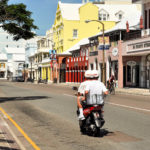By Richard Ammon
GlobalGayz.com
May 20, 2011
Surrounding the upscale condo towers and long white beaches of Rio de Janiero, up on the hills, there are numerous slum neighborhoods, shanty towns, where millions of people live in substandard housing with open sewers, tangled electric wires, broken walkways, private militias and drug gangs with machine guns as well as honest ordinary people with low paying jobs.
Rio’s favelas appeared in the 1970s when many jobless rural people moved to urban areas hoping for a better life–in addition to the already impoverished city dwellers.
But with minimum skills and children in tow finding an affordable place to live became a nightmare and many people were forced to move ‘uphill’ into a favela (neighborhoods). Today Rio has more than 500 favelas (Sao Paulo has more than 600.)
The problems of life in these ‘hoods seem endless: basic housing, safety, schools, medical care, clean water, earning a living. A recent innovative enterprise has been turning the favelas into tourist attractions with guides leading small groups through the narrow twisting alleyways among the extremely dense and crowded dwellings.
I took a tour through the biggest favela in Rio, Rocinha, during my recent trip. All appeared chaotic but controlled. It’s impossible for an outsider to understand the social structure here given the ‘layers’ of control and influence. City officials, city police, federal military units, neighborhood bosses, drug gangs, armed youth militias. Our guide led our group (quickly. so as not to linger and perhaps see something illegal) down through a winding broken route cheered only by colorful graffiti and glimpses of the city and sea far below.
 We stopped at an artists’ cooperative, a bakery, crafts
We stopped at an artists’ cooperative, a bakery, crafts  shop and were treated to a spontaneous dance performance by a darling 9 year-old boy (apparently on his way home from school) accompanied by a ‘bang-on-a-can’ band using plastic buckets and tin cans as instruments.
shop and were treated to a spontaneous dance performance by a darling 9 year-old boy (apparently on his way home from school) accompanied by a ‘bang-on-a-can’ band using plastic buckets and tin cans as instruments.
The ‘music’ was rhythmic and the boy’s dance (tap, Michael Jackson and street rap dance) was quite engaging. Afterwards, of course, we tipped the group–another enterprise in this hard luck place.
Our visit was peaceful and safe but it’s not always like this; see photos of a police raid on drug gangs. “Between December of 1987 and November 2001, violent death claimed 3,937 Rio youths under 18 years of age, mostly drug gang ‘soldiers’. By comparison, during the same period, 467 minors died in and around the West Bank between Jordan and Israel, which is considered a war zone by the international community.” (BrazilMax News)… In Rio de Janeiro, it is said that the difference between a living veteran cop and a dead rookie is the split second it takes to think twice about killing a child because you never know if he is armed or not. (BrazilMax News 2003)
 But like death, life goes on and most people want to move forward with their meager lives perhaps catching the occasional glimmer of hope. There are also charitable organizations in the favelas that run day-care centers, schools, medical clinics, church safe havens. Laundry is washed. TVs glow at night with sit-coms. Books are read…and pretty wrist bands (photo right) are hand-made and sold by enterprising mothers to support their families. It’s love among the ruins.
But like death, life goes on and most people want to move forward with their meager lives perhaps catching the occasional glimmer of hope. There are also charitable organizations in the favelas that run day-care centers, schools, medical clinics, church safe havens. Laundry is washed. TVs glow at night with sit-coms. Books are read…and pretty wrist bands (photo right) are hand-made and sold by enterprising mothers to support their families. It’s love among the ruins.
















